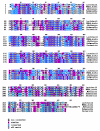Potential Antibacterial Targets in Bacterial Central Metabolism
- PMID: 24151543
- PMCID: PMC3800682
Potential Antibacterial Targets in Bacterial Central Metabolism
Abstract
The emerging antibiotic resistant bacteria and their abilities for rapid evolution have pushed the need to explore alternative antibiotics less prone to drug resistance. In this study, we employed methicillin/multidrug-resistant Staphylococcus aureus (MRSA) as a model bacterial system to initiate novel antibiotic development. An in silico identification of drug targets in MRSA 252 strain and MRSA Mu50 strain respectively was described. The identified potential targets were classified according to their known or putative functions. We discovered that a class of essential non-human homologous, central metabolic enzymes falls into the scope of potential drug targets for two reasons: 1) the identified targets either do not have human counterparts or use alternative catalytic mechanisms. Based on major differences in active site structure and catalytic mechanism, an inhibitor of such a bacterial enzyme can be designed which will not inhibit its human cousin. 2) attacking bacterial energy-making machinery bypasses the usual drug resistance sites, paving the road to multi-faceted approaches to combat antibiotic resistance.
Keywords: Methicillin/multidrug-resistant Staphylococcus aureus; antibiotic resistance; central metabolism; drug targets; essential genes.
Figures


References
-
- Haag NL, Velk KK, Wu C. Proc. Third International Conference on Bioinformatics, Biocomputational Systems and Biotechnologies, BIOTECHNO 2011. IARIA XPS Press; Venice, Italy: May 22-27, 2011. In silico Identification of Drug Targets in Methicillin/Multidrug-Resistant Staphylococcus aureus; pp. 91–99. ISBN: 978-1-61208-007-9.
-
- Walsh CT. Antibiotics: Actions, Origin, Resistance. ASM Press; Washington, DC: 2003.
-
- Levy SB. Antibiotic and antiseptic resistance: impact on public health. Pediatr. Infect. Dis. J. 2000 Oct.Vol. 19:S120–S122. - PubMed
-
- Levy SB. The antibiotic paradox: how miracle drugs are destroying the miracle. Plenum; New York: 1992.
-
- Tenover FC. Mechanisms of antimicrobial resistance in bacteria. Am. J. Med. 2006 Jun;vol. 119(6 Suppl 1):S3–S10. doi:10.1016/j.ajic.2006.05.219. - PubMed
Grants and funding
LinkOut - more resources
Full Text Sources
Molecular Biology Databases
